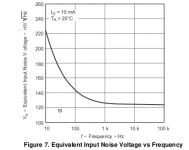If post 20 is an answer to posts 16...19, I don't understand the answer. It is unclear to me whether that 2 mV is RMS, peak or peak-peak and what part of it is noise. If it were 2 mV RMS noise, that would be terrible, even over a bandwidth of 100 MHz it would still be 200 nV/sqrt(Hz).
That is DC with 2mVAC p-p AC waveform without signal = noise. In context, and measured experience expect 7x without what was mentioned. Would I use a diode as bypass for a bias resistor? Got the right voltage drop? .. maybe, and I think it is one of those things - if it sounds better. Fortunately, I don't have that problem..
Just trying to help the OP.. try the above - was clearly apparent on my CRO. To the rest, kind regards.
HK
Just trying to help the OP.. try the above - was clearly apparent on my CRO. To the rest, kind regards.
HK
Last edited:
Anyway, there is a plot of the equivalent noise at the REF terminal in the TL431 datasheet. The white part is around 125 nV/sqrt(Hz), some 20 dB to 28 dB above the average A- and RIAA- weighted audio noise level you can obtain with a good optimally biased triode, so be a bit careful with it in low-noise stages. By the way, there is also an impedance plot showing that the impedance is nearly flat until 100 kHz at 10 mA cathode current.
Attachments
Last edited:
- Status
- This old topic is closed. If you want to reopen this topic, contact a moderator using the "Report Post" button.
